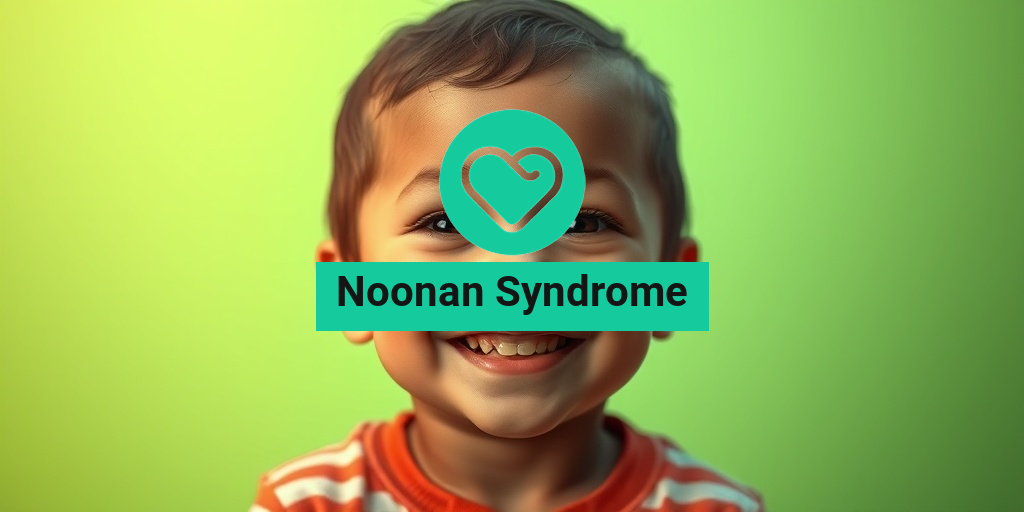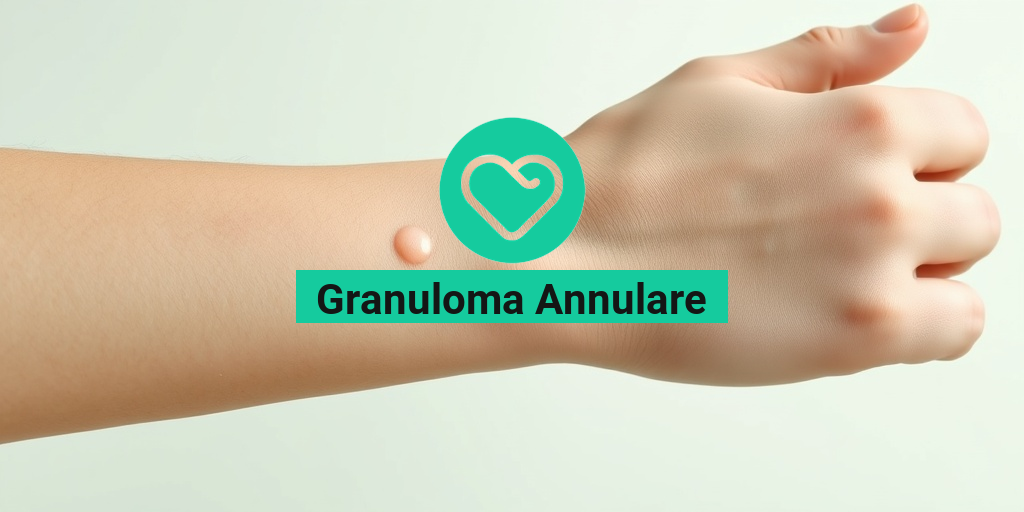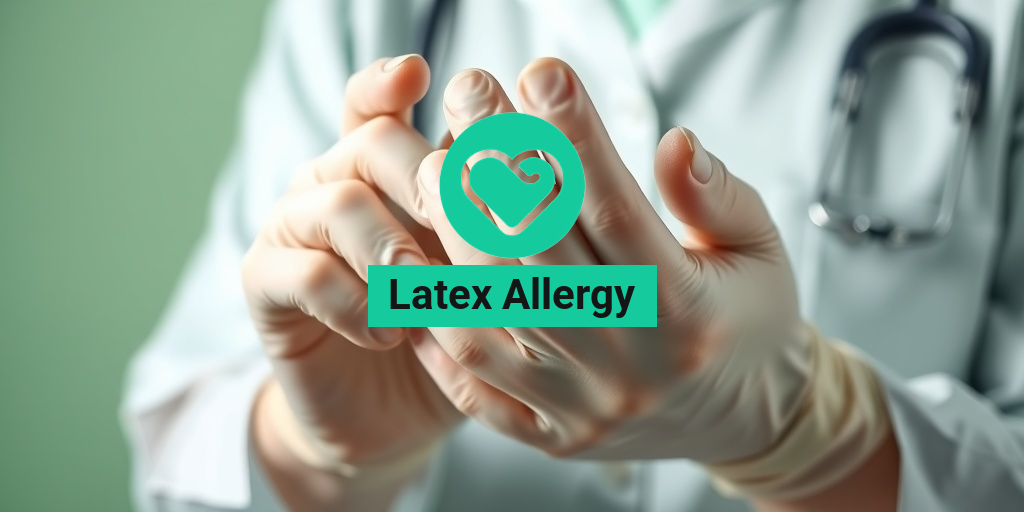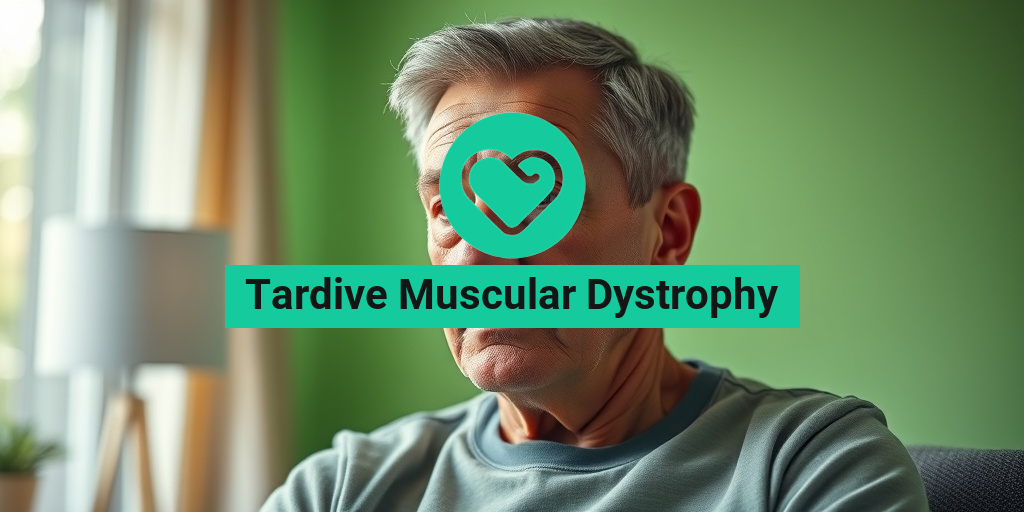What Is Noonan Syndrome?
Noonan Syndrome is a genetic disorder that affects various parts of the body, leading to a range of physical and developmental challenges. It is caused by mutations in genes that are involved in the RAS/MAPK signaling pathway, which plays a crucial role in cell growth and development. This condition is typically present at birth and can affect both males and females equally.
First identified in the 1960s by Dr. Jacqueline Noonan, this syndrome is characterized by a distinct set of features and health issues. While the exact prevalence of Noonan Syndrome is not fully known, it is estimated to occur in about 1 in 1,000 to 1 in 2,500 live births. The condition can vary significantly in its expression, meaning that no two individuals with Noonan Syndrome will have the same experience.
Genetics of Noonan Syndrome
Noonan Syndrome is primarily inherited in an autosomal dominant manner, which means that only one copy of the mutated gene from an affected parent can cause the disorder in their child. The most common genes associated with Noonan Syndrome include PTPN11, KRAS, SOS1, and RAF1. Genetic testing can help confirm a diagnosis and provide valuable information for families.
Why Is Early Diagnosis Important?
Early diagnosis of Noonan Syndrome is crucial for managing the condition effectively. It allows for timely interventions, such as regular monitoring of heart health, growth assessments, and developmental support. Families can also benefit from genetic counseling, which can provide insights into the inheritance patterns and implications for future pregnancies.
Noonan Syndrome Symptoms
The symptoms of Noonan Syndrome can vary widely among individuals, but there are several common features that many people with the condition may exhibit. Understanding these symptoms can help in early identification and management of the syndrome.
Physical Features
- Distinctive Facial Features: Individuals with Noonan Syndrome often have unique facial characteristics, including a broad forehead, widely spaced eyes, a short neck, and low-set ears.
- Short Stature: Many children with Noonan Syndrome experience growth delays, leading to shorter-than-average height.
- Chest Deformities: Some individuals may have a condition known as pectus excavatum (sunken chest) or pectus carinatum (protruding chest).
Cardiac Issues
Heart defects are common in individuals with Noonan Syndrome, with approximately 50-80% of affected individuals experiencing some form of congenital heart disease. The most prevalent heart conditions include:
- Pulmonary Stenosis: A narrowing of the outflow tract from the right ventricle to the pulmonary artery.
- Atrial Septal Defect: A hole in the wall separating the heart’s upper chambers.
Developmental and Behavioral Challenges
Children with Noonan Syndrome may also face developmental delays, particularly in speech and motor skills. Behavioral issues, such as attention deficit hyperactivity disorder (ADHD), can also be more prevalent in this population. Early intervention programs can significantly improve outcomes for these children.
Other Associated Health Issues
In addition to the above symptoms, individuals with Noonan Syndrome may experience:
- Hearing Loss: Some may have conductive hearing loss due to ear abnormalities.
- Vision Problems: Strabismus (crossed eyes) and other vision issues are not uncommon.
- Bleeding Disorders: Some individuals may have issues with blood clotting, leading to easy bruising or prolonged bleeding.
Understanding the symptoms of Noonan Syndrome is essential for parents and caregivers. If you suspect that your child may have this condition, it is important to consult with a healthcare professional for a comprehensive evaluation and appropriate management.
For more information and resources on Noonan Syndrome, consider visiting Yesil Health AI, where you can find evidence-based health answers tailored to your needs. 🌟
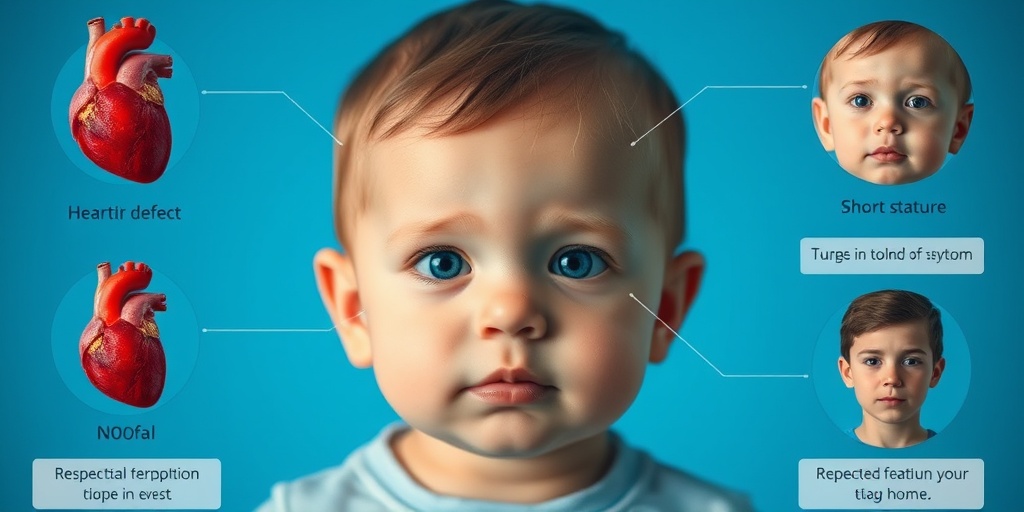
Causes of Noonan Syndrome
Noonan Syndrome is a genetic disorder that affects various parts of the body, leading to a range of physical and developmental challenges. Understanding the causes of Noonan Syndrome is crucial for parents, caregivers, and healthcare professionals. This condition is primarily caused by mutations in specific genes that play a role in cell growth and development.
Genetic Mutations
The majority of Noonan Syndrome cases are linked to mutations in genes such as PTPN11, KRAS, SOS1, and RAF1. These genes are involved in the RAS/MAPK signaling pathway, which is essential for normal cell division and growth. When these genes are mutated, it can lead to the characteristic features of Noonan Syndrome.
Inheritance Patterns
Noonan Syndrome is typically inherited in an autosomal dominant manner. This means that only one copy of the mutated gene from an affected parent can cause the syndrome in their child. However, not all cases are inherited; some may occur as a result of new mutations during the formation of reproductive cells or in early embryonic development.
Types of Genetic Testing
If Noonan Syndrome is suspected, genetic testing can confirm the diagnosis. This testing can identify specific mutations in the genes associated with the syndrome. Early diagnosis is vital as it allows for timely interventions and management of symptoms.
Risk Factors for Noonan Syndrome
While Noonan Syndrome can affect anyone, certain risk factors may increase the likelihood of a child being born with this condition. Understanding these factors can help in early detection and management.
Family History
A family history of Noonan Syndrome or related genetic disorders can significantly increase the risk. If a parent has the syndrome, there is a 50% chance that their child will inherit the condition. Genetic counseling is often recommended for families with a history of Noonan Syndrome to understand their risks better.
Parental Age
Research suggests that advanced parental age, particularly maternal age, may be associated with an increased risk of genetic disorders, including Noonan Syndrome. Older parents may have a higher chance of passing on genetic mutations that could lead to this condition.
Environmental Factors
While Noonan Syndrome is primarily genetic, some studies suggest that environmental factors during pregnancy, such as exposure to certain medications, drugs, or infections, might play a role in the development of genetic mutations. However, more research is needed to establish a clear link.
Associated Conditions
Children with Noonan Syndrome may also have other health issues, such as congenital heart defects, which can complicate their overall health. These associated conditions can sometimes be a clue for healthcare providers to consider Noonan Syndrome during diagnosis.
In summary, understanding the causes and risk factors of Noonan Syndrome is essential for early diagnosis and management. If you suspect that your child may have this condition, consulting with a healthcare professional for genetic testing and counseling is a crucial step. 🧬
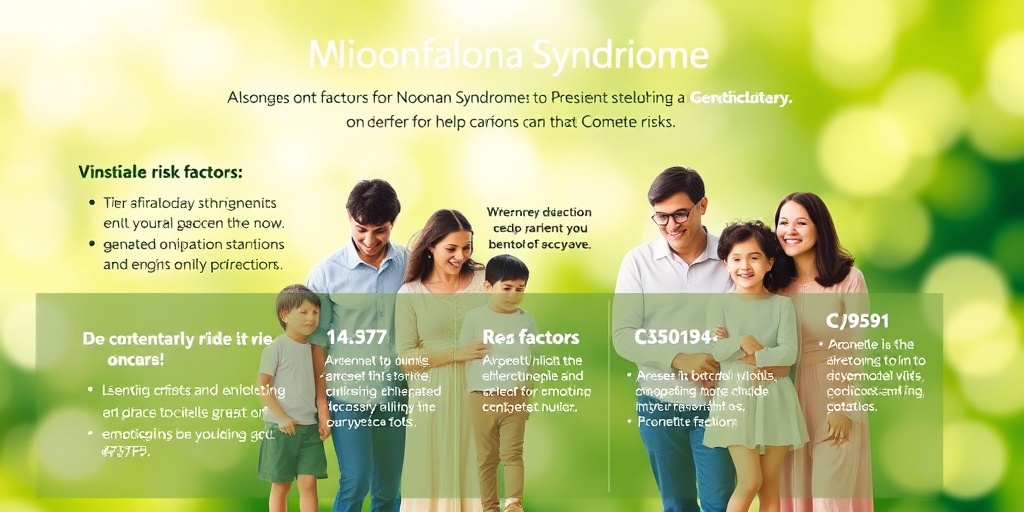
Diagnosing Noonan Syndrome
Noonan Syndrome is a genetic disorder that can affect various parts of the body, leading to a range of symptoms and complications. Early diagnosis is crucial for managing the condition effectively. But how is Noonan Syndrome diagnosed? Let’s explore the process.
Clinical Evaluation
The first step in diagnosing Noonan Syndrome typically involves a thorough clinical evaluation. Healthcare providers will look for characteristic features associated with the syndrome, which may include:
- Distinctive facial features: These can include a broad forehead, widely spaced eyes, and a short neck.
- Growth issues: Children with Noonan Syndrome often experience short stature.
- Heart defects: Many individuals have congenital heart problems, which can be a significant indicator.
- Developmental delays: Some children may face challenges in reaching developmental milestones.
Genetic Testing
While clinical evaluation is essential, genetic testing plays a pivotal role in confirming a diagnosis of Noonan Syndrome. This testing looks for mutations in specific genes, most commonly the PTPN11 gene, but also others like KRAS and SOS1. A positive result can provide definitive evidence of the syndrome.
Family History
Understanding the family history is also important. Noonan Syndrome can be inherited in an autosomal dominant manner, meaning that only one copy of the mutated gene from an affected parent can lead to the condition in their child. If there is a known family history of Noonan Syndrome, this information can aid in the diagnostic process.
Multidisciplinary Approach
Diagnosing Noonan Syndrome often requires a multidisciplinary approach. Specialists such as geneticists, cardiologists, and developmental pediatricians may collaborate to assess the patient comprehensively. This teamwork ensures that all aspects of the syndrome are considered, leading to a more accurate diagnosis and tailored management plan.
Complications of Noonan Syndrome
Noonan Syndrome can lead to a variety of complications that may affect an individual’s health and quality of life. Understanding these complications is essential for effective management and support.
Cardiovascular Issues
One of the most significant complications associated with Noonan Syndrome is cardiovascular problems. Many individuals with the syndrome are born with congenital heart defects, such as:
- Pulmonary stenosis: A narrowing of the outflow tract from the right ventricle to the pulmonary artery.
- Atrial septal defects: Holes in the wall separating the heart’s upper chambers.
- Hypertrophic cardiomyopathy: Thickening of the heart muscle, which can lead to heart failure.
Regular monitoring and, in some cases, surgical intervention may be necessary to manage these conditions effectively. ❤️
Growth and Developmental Delays
Children with Noonan Syndrome often experience growth delays and may be shorter than their peers. Additionally, they may face developmental delays that can impact their learning and social skills. Early intervention programs, including physical therapy and special education services, can be beneficial in addressing these challenges.
Hematological Issues
Individuals with Noonan Syndrome may also be at risk for hematological complications, such as bleeding disorders. This is due to potential issues with blood clotting, which can lead to easy bruising or prolonged bleeding from cuts. Regular check-ups with a hematologist can help manage these risks.
Psychosocial Challenges
The unique features and health challenges associated with Noonan Syndrome can lead to psychosocial issues for affected individuals. They may experience social stigma or bullying, which can impact their self-esteem and mental health. Support from mental health professionals, along with family and community support, is crucial in helping individuals navigate these challenges.
In summary, diagnosing Noonan Syndrome involves a combination of clinical evaluation, genetic testing, and a thorough understanding of family history. The complications associated with the syndrome can be diverse, affecting various aspects of health and development. Early diagnosis and comprehensive management can significantly improve the quality of life for those affected. 🌟

Treatment Options for Noonan Syndrome
Noonan Syndrome is a genetic disorder that can affect various parts of the body, leading to a range of symptoms and health challenges. While there is currently no cure for Noonan Syndrome, there are several treatment options available to help manage the symptoms and improve the quality of life for those affected. Understanding these options is crucial for families and individuals navigating this condition.
Medical Management
One of the primary approaches to treating Noonan Syndrome involves medical management. This can include regular check-ups with a team of healthcare professionals, including pediatricians, cardiologists, and geneticists. Here are some common medical interventions:
- Cardiac Care: Many individuals with Noonan Syndrome have congenital heart defects. Regular monitoring and, if necessary, surgical interventions can help manage these issues.
- Growth Hormone Therapy: Some children with Noonan Syndrome may experience growth delays. Growth hormone therapy can be beneficial in promoting growth and achieving a more typical height.
- Hearing and Vision Support: Regular screenings for hearing and vision problems are essential, as these can be common in individuals with Noonan Syndrome. Hearing aids or glasses may be recommended as needed.
Therapeutic Interventions
In addition to medical management, various therapeutic interventions can support individuals with Noonan Syndrome:
- Physical Therapy: This can help improve motor skills and coordination, which may be affected in some individuals.
- Occupational Therapy: Occupational therapists can assist with daily living skills and help individuals adapt to their environment.
- Speech Therapy: For those with speech delays or difficulties, speech therapy can be invaluable in enhancing communication skills.
Psychosocial Support
Living with Noonan Syndrome can be challenging, not just physically but also emotionally. Psychosocial support is an essential component of treatment:
- Counseling: Individual or family counseling can provide emotional support and coping strategies for dealing with the challenges of the syndrome.
- Support Groups: Connecting with others who have Noonan Syndrome can foster a sense of community and understanding.
Living with Noonan Syndrome
Living with Noonan Syndrome presents unique challenges, but with the right support and resources, individuals can lead fulfilling lives. Understanding the condition and its implications is key to navigating daily life.
Daily Life and Routine
Establishing a structured daily routine can be beneficial for individuals with Noonan Syndrome. Here are some tips for creating a supportive environment:
- Consistent Schedule: A predictable daily routine can help reduce anxiety and provide a sense of security.
- Healthy Lifestyle: Encouraging a balanced diet and regular physical activity can promote overall health and well-being.
- Regular Medical Check-ups: Keeping up with medical appointments is crucial for monitoring health and addressing any emerging issues.
Education and Social Integration
Education plays a vital role in the development of children with Noonan Syndrome. Here are some considerations:
- Individualized Education Plans (IEPs): Many children may benefit from tailored educational plans that address their specific learning needs.
- Social Skills Training: Programs that focus on developing social skills can help individuals with Noonan Syndrome build friendships and navigate social situations.
Advocacy and Awareness
Raising awareness about Noonan Syndrome is essential for fostering understanding and support within the community. Here are ways to advocate:
- Educate Others: Sharing information about Noonan Syndrome can help dispel myths and promote acceptance.
- Participate in Awareness Campaigns: Joining or supporting organizations dedicated to Noonan Syndrome can amplify voices and resources.
Living with Noonan Syndrome may come with its challenges, but with the right treatment options and support systems in place, individuals can thrive and lead meaningful lives. 🌟

Frequently Asked Questions about Noonan Syndrome
What is Noonan Syndrome?
Noonan Syndrome is a genetic disorder that affects various parts of the body. It is characterized by distinctive facial features, short stature, heart defects, and other health issues. The condition is caused by mutations in certain genes that are involved in cell growth and development.
What are the common symptoms of Noonan Syndrome?
Individuals with Noonan Syndrome may exhibit a range of symptoms, including:
- Distinctive facial features: Such as a broad forehead, wide-set eyes, and a short neck.
- Short stature: Many children with this syndrome grow more slowly than their peers.
- Heart defects: Congenital heart problems are common, including pulmonary stenosis.
- Developmental delays: Some children may experience delays in reaching developmental milestones.
How is Noonan Syndrome inherited?
Noonan Syndrome is typically inherited in an autosomal dominant manner, meaning that only one copy of the mutated gene from an affected parent can cause the disorder in their child. However, it can also occur as a new mutation in individuals with no family history of the condition.
Can Noonan Syndrome be diagnosed in babies?
Yes, Noonan Syndrome can be diagnosed in babies, often through physical examination and genetic testing. Early diagnosis is crucial for managing symptoms and providing appropriate care.
What are the treatment options for Noonan Syndrome?
While there is no cure for Noonan Syndrome, treatment focuses on managing symptoms and associated health issues. This may include:
- Regular monitoring: To track growth and development.
- Cardiac care: For those with heart defects, specialized care may be necessary.
- Therapies: Such as physical therapy or speech therapy to support development.
How does Noonan Syndrome compare to Turner Syndrome?
Noonan Syndrome and Turner Syndrome are both genetic disorders, but they have different causes and symptoms. Turner Syndrome primarily affects females and is caused by the absence of one X chromosome, while Noonan Syndrome can affect both males and females and is caused by mutations in various genes. The symptoms and health issues associated with each syndrome also differ significantly.
Where can I find support for Noonan Syndrome?
Support for families affected by Noonan Syndrome can be found through various organizations and online communities. These resources provide information, connect families, and offer emotional support. Consider reaching out to genetic counseling services or local support groups for assistance.

